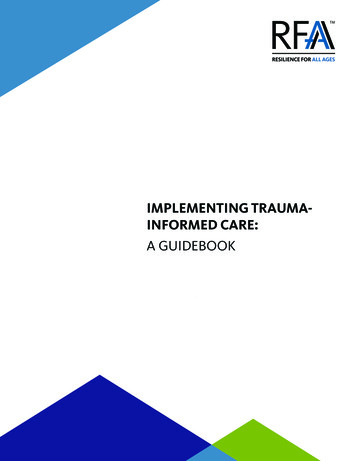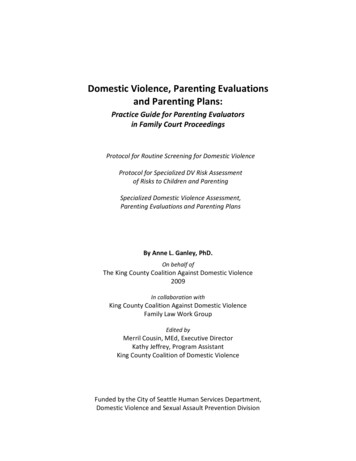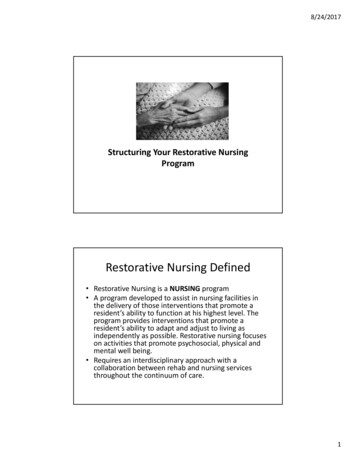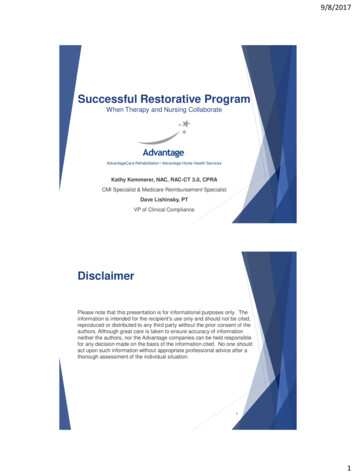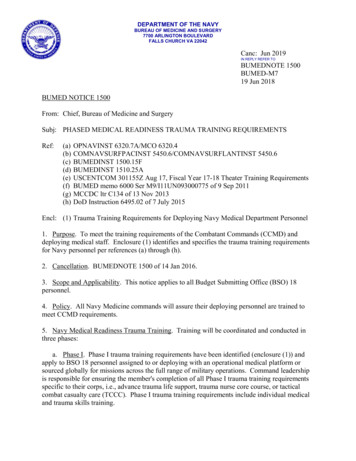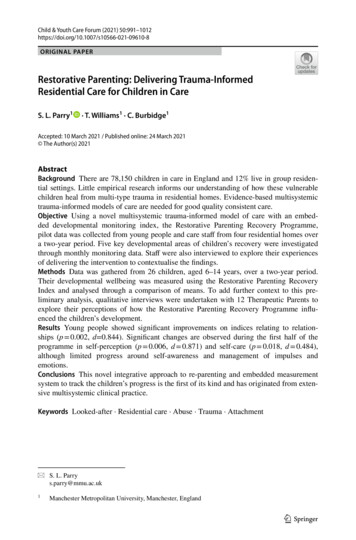
Transcription
Child & Youth Care Forum (2021) 610-8ORIGINAL PAPERRestorative Parenting: Delivering Trauma‑InformedResidential Care for Children in CareS. L. Parry1· T. Williams1 · C. Burbidge1Accepted: 10 March 2021 / Published online: 24 March 2021 The Author(s) 2021AbstractBackground There are 78,150 children in care in England and 12% live in group residential settings. Little empirical research informs our understanding of how these vulnerablechildren heal from multi-type trauma in residential homes. Evidence-based multisystemictrauma-informed models of care are needed for good quality consistent care.Objective Using a novel multisystemic trauma-informed model of care with an embedded developmental monitoring index, the Restorative Parenting Recovery Programme,pilot data was collected from young people and care staff from four residential homes overa two-year period. Five key developmental areas of children’s recovery were investigatedthrough monthly monitoring data. Staff were also interviewed to explore their experiencesof delivering the intervention to contextualise the findings.Methods Data was gathered from 26 children, aged 6–14 years, over a two-year period.Their developmental wellbeing was measured using the Restorative Parenting RecoveryIndex and analysed through a comparison of means. To add further context to this preliminary analysis, qualitative interviews were undertaken with 12 Therapeutic Parents toexplore their perceptions of how the Restorative Parenting Recovery Programme influenced the children’s development.Results Young people showed significant improvements on indices relating to relationships (p 0.002, d 0.844). Significant changes are observed during the first half of theprogramme in self-perception (p 0.006, d 0.871) and self-care (p 0.018, d 0.484),although limited progress around self-awareness and management of impulses andemotions.Conclusions This novel integrative approach to re-parenting and embedded measurementsystem to track the children’s progress is the first of its kind and has originated from extensive multisystemic clinical practice.Keywords Looked-after · Residential care · Abuse · Trauma · Attachment* S. L. Parrys.parry@mmu.ac.uk1Manchester Metropolitan University, Manchester, England13Vol.:(0123456789)
992Child & Youth Care Forum (2021) 50:991–1012IntroductionThere are currently 78,150 children in care in England (Department for Education,2019), a 4% increase from 2018, with 63% of children entering the care system dueto abuse and neglect at home. The National Society for the Prevention of Cruelty toChildren’s (NSPCC) definition of what it means to be in care is that a child is deemedto be in care if they have been in the care of their local authority for more than 24 h. Ofthe 9378 children and young people who enter long-term residential care (e.g. secureunits, children’s homes or semi-independent living accommodation), the percentage ofchildren who have experienced multi-type trauma is even higher. These are arguablythe most vulnerable group of young people in care and the system they enter is notcurrently statutorily regulated, with only a proportion of children’s homes regulatedand regularly inspected by Ofsted; the Office for Standards in Education, Children’sServices and Skills in England. Therefore, vulnerable children and young people whohave experienced multiple traumas and relational losses are at risk of further instability and re-traumatisation through a system in need of theoretically robust traumainformed models of care with empirical evidence to support their implementation.It is comprehensively understood that adversities in childhood can impact globaldevelopment, particularly in relation to psychological sequelae (Cashmore & Shackel,2014; Gilbert et al., 2009; Varese et al., 2012), highlighting “few associations in themental health literature are as well established as the relationship between child abuseand neglect and adverse psychological consequences among adults” (Horwitz, Widom,McLaughlin, & White, 2001, p. 184). Further, children in care are overly representedacross youth and adult forensic services, homeless populations, and more likely toexperience re-victimisation and exploitation if they have not experienced positive andsecure relationships during childhood (Brännström et al., 2017). Children in care arefive times more likely to be excluded from school compared to their peers (Education,2018, 2019) and 39% of the children in youth forensic centres are looked-after children(Simmonds, 2016). Looked after children are four times more likely to experience amental health condition and only 14% achieve 5 A*-C grades at age 16 (Bazalgetteet al., 2015; Education, 2017).Overall, outcomes for looked after children are concerning, with education breakdown and involvement with the criminal justice system too common (Berridge, 2008;Halvorsen, 2014; Meltzer et al., 2003; Schofield et al., 2015). Despite the interest inadverse childhood experiences (ACEs) and psychological health in the general population, combined with a recognition that children in care have greater mental healthneeds than children of the same age in the general population (McCann et al., 1996;Parry & Weatherhead, 2014), research into the psychosocial impact of being lookedafter is extremely limited (Mullan et al., 2007; Richardson & Lelliott, 2003). It is however established that looked-after children are amongst the most vulnerable in society(Morrison & Shepherd, 2015), experiencing many challenges to good mental health(Committee, 2016; Villodas et al., 2016), with problems extending into adulthood formany (Teyhan et al., 2018). This incredibly vulnerable and growing group of youngpeople are disadvantaged across their developmental trajectories, which has an impactupon health, social care and educational systems. Therefore, there is a clear need foreffective interventions to help these young people to reduce the impact of childhoodhardships in adulthood.13
Child & Youth Care Forum (2021) 50:991–1012993Trauma‑Informed Care for Looked After ChildrenTrauma-informed care (TIC) has developed in response to the overwhelming evidence thatchildren in residential care settings have high ACE scores and poor health outcomes (Felittiet al., 1998; Selwyn et al., 2017; Simkiss, Stallard, & Thorogood, 2013). TIC recognizesthe impact of a history of trauma for a person’s day-to-day living and the need for traumaaware staff who can provide safe containment and reduce the likelihood of re-traumatization (Cannon et al., 2020). Consequently, many models of residential care share similarunderpinnings in relation to attachment frameworks and trauma-informed care (TIC).Attachment theory is the theoretical framework that can help us understand how andwhy children are biologically, psychologically and socially driven to form close bondsand connections from birth, usually with one or two main attachment figures, most oftenparents (Bowlby, 1959). Within TIC models for children’s residential care, the attachmentfigure is often the child’s key worker. One-to-one mentorship to nurture hopeful thinkinghas also been shown to be very effective for children in residential care in Israel (SulimaniAidan et al., 2019). Primary research with young people in residential care in Australia hashighlighted that competent and trustworthy carers were essential for a care experience thatfelt positive and safe (Moorea, McArthurb, Deathc, Tilburyd, & Roche, 2017). However,where there is often a high attrition of staff and teams working shift patterns, there aremany inconsistencies and unpredictabilities that are unavoidable within residential care.Children in care often experience further trauma due to multiple placement breakdownsalongside frequent school, family and peer-group transitions (Haggman-Laitila et al.,2019; Parry & Weatherhead, 2014), all of which incur further relational instability andlosses. Accordingly, by the point children reach a residential setting, it becomes essential todirectly target complex trauma through trauma-informed therapeutic care.Organisations providing TIC need to create a safe space, empower service user involvement and voice, identify trauma-related needs at individual and systemic levels, nurturea culture of wellbeing and resilience for individuals and the organisation as a whole, andwork with a ‘whole systems’ approach, supporting cross-agency collaboration and integrated communication (Dermody et al., 2018; Wilson, Pence, & Conradi, 2013). Lookedafter children’s services can face barriers in terms of delivering TIC due to difficulties incare coordination between an extensive range of health, social care and educational organisations; in addition to attending to the psychosocial needs of the young people and frontline workers, whilst maintaining therapeutic physical environments (Robinson & Brown,2016) for both children and staff. Often, competing demands and complex needs outweighavailable resources, which can result in suboptimum standards of care.Therapeutic models and approaches applied to the residential childcare setting usually aim to create a nurturing culture through positive secure relationships and building resilience (Hummer, Dollard, Robst, & Armstrong, 2010). A number of interventionapproaches have been reviewed over recent years (Clarke, 2011; Macdonald, Millen,McCann, Roscoe, & Ewart-Boyle, 2102), although it is recognised that further practiceoriented research is required (Roberts et al., 2016). Several models of care have been evaluated, including the Model of Attachment Practice, Sanctuary Model, Positive Peer Culture,Dyadic Developmental Psychotherapy, and CARE (Children and Residential Experiences),with many sharing similar attachment based underpinnings (Clarke, 2011; Macdonaldet al., 2102; Ribbens McCarthy et al., 2013; Whittaker et al., 2015). The only realist systematic review of inpatient and residential TIC for young people identified 13 studies forinclusion, which had participant numbers of 53–6361 young people (Bryson et al., 2017).13
994Child & Youth Care Forum (2021) 50:991–1012The five factors that determined the success of implementing TIC across residential andinpatient initiatives were: “senior leadership commitment, sufficient staff support, amplifying the voices of patients and families, aligning policy and programming with traumainformed principles, and using data to help motivate change”. It is not currently knownwhich of these factors are also relevant to residential homes for children in care specifically. Further, without standardised outcome measures and agreed means through whichto evaluate all models for individual children across services, robust comparisons betweenthe models is presently impossible. Finally, the mechanisms of change that occur throughgood quality care practices are not well understood, which further complicates the processof measuring positive change.In summary, the existing empirical literature exploring therapeutic approaches forlooked-after children who have experienced multi-type trauma suggests there are manyaspects common to all of these established approaches. These comparable aspects are arecognition that children in residential care have experienced multi-type trauma and disadvantage, the belief that staff are required to understand the communicative needs andemotions underlying behaviours, and that staff and children will require support aroundemotional stabilisation and stress resilience (Macdonald et al., 2102; Ribbens McCarthyet al., 2013; Whittaker et al., 2015).The current paper presents preliminary findings of emerging data from a novel integrative multisystemic trauma-informed approach to residential care and monitoring data,tracking children’s developmental progress across strategic developmental areas. It hasbeen suggested that sharing data may help motivate change (Bryson et al., 2017) and moreservice level research is required in the field of residential care for looked-after children(Roberts et al., 2016). Further, the novel programme presented with preliminary data offersan incremental contribution to this under-researched area of children’s services and thetrauma literature in terms of a novel approach to care and measuring progress, within initial insights into how children start to heal from trauma with suitable support.Introducing the Restorative Parenting Recovery ProgrammeThe Restorative Parenting Recovery Programme (RPRP; Robinson & Philpot, 2016) isbased upon attachment theory, positive psychology and TIC. Within the RPRP, the child’sattachment figure is their key worker, known as the therapeutic parent (TP), recognisingthe therapeutic aspect of their role within a TIC approach and the importance of stabilityand consistency for the child. Consequently, practical and therapeutic care for the child isdelivered through the TP, with additional supervisory support and monthly team consultations with a member of the clinical team in place to support the TPs. Positive psychology isthe study of positive subjective experience in the form of individuality and systemic influences to improve quality of life (Seligman & Csikszentmihalyi, 2000). The role of positive psychology for TIC models of residential care is emerging, although has potential tosignificantly lift expectations and aspirations away from pathology and problems towardsstrengths and successes for staff and children alike. The concept of hope has been definedas the combination of a person’s belief in their ability to achieve their goals (their agency)and plan a variety of ways to succeed in the goal (the pathways; Snyder, 1994). Throughadopting a positive and solutions focused approach (recently reviewed in Zatloukal et al.,2020), the language can change from being problem focused to solution focused, supporting the child to expand their agency and pathway planning ability. This approach underpinsthe programme on the assumption that the children have experienced trauma and relational13
Child & Youth Care Forum (2021) 50:991–1012995loss, and that their thoughts, behaviours and relational styles, to themselves and others,will have been significantly affected by these traumas. Therefore, appreciating the child’sactions as communications and clues as to how they may have learned to cope, rather thanpathologizing their presentation, the TPs can develop a working formulation as to how thechild is coping in the here-and-now, informing their care plan.With training and support, staff can help a young person develop their self-belief andagency through looking for success instead of failures and positive experiences or accomplishments, however small, instead of negativities. This is the ethos of the RPRP and allstaff consultations are undertaken with solutions focused language used to encourage solutions focused thinking. For example, if a TP is feeling stuck or as though they cannot seeprogress, they are encouraged to think about how they and the child have prevented mattersgetting worse. If a TP is doubting how progress can be maintained, they are supported toexplore their strengths as a practitioner and those of the child to nurture hopefulness.The RPRP operates on an environmental, sensory, interpersonal, individual and organisational level (Fig. 1). Security and safety are operationalised through therapeutic relationships and careful consideration of the sensory living environment. Monthly consultationswith TPs and progress monitoring support engagement with the clinical team and time forsafe reflection for frontline staff, essential for reflexive practice (Thomas & Isobel, 2019).Underpinning this is an education programme from which no child is ever excluded, providing small scale person-centred education that embraces the national curriculum as wellas individual needs and TIC in education. The positive impact of trauma-informed residential schools has been evidenced in recent literature as beneficial to wellbeing and learning(Day et al., 2015), although it is recognised further research is required in this area (Berger,2019).Collaborative interprofessional working between the clinical, counselling and educational psychology team with TPs, educators and external agencies (e.g. social services,external schools, community groups and healthcare services) supports cohesion in thechild’s world. Uniquely, the RPRP recognises that as a result of ACEs, the child’s regulation systems can be hypersensitive and hyper-responsive, causing difficulties for the childFig. 1 The multisystemic approach of the RPRP13
996Child & Youth Care Forum (2021) 50:991–1012in re-calibrating arousal levels to the general environment (Van der Kolk, 2003). Therefore,a central focus of RPRP is to comprehensively provide a tailored low-arousal therapeuticenvironment, thus reducing the frequency and intensity of a child’s stress response to theirenvironment (Shonkoff et al., 2015). The combination of a low-stimulus home environment(e.g. low arousal decoration, soft lighting, soft carpets to reduce noise, avoiding perfumesand unnecessary clutter; (Gaudion, Hall, Myerson, & Pellicano, 2015; Vogel, 2008) andconsistent and accepting interpersonal relationships with TPs are essential to the core healing process. This is prioritised because it is well documented that children who have suffered past trauma can unconsciously revisit sensations associated with that trauma whentriggered in the here-and-now by sensory stimuli that were encoded as part of their traumatic experiences (Gaskill & Perry, 2011). This can therefore cause re-traumatisation at atime when the child has not developed the capacity to deal with these sensations (Furnivall& Grant, 2014; Van der Kolk, 2003).All of the children’s homes function as a unique family unit and are integrated into thelocal community to help the children recognise and begin to experience family living. Forexample, day trips and visits to suitable play areas and centres are arranged and childrenare encouraged to join local sports groups and clubs when they are socially and emotionally ready to do so. If a child continues to struggle to form relationships with peers, alternatives are explored to help the child develop their confidence and social skills (e.g. activitieswith art/animals). This process of safely connecting a child to their community throughtheir interests and strengths is a novel and important transitional process within RPRP.The RPRP encompasses the Restorative Parenting Recovery Index (RPRI; Robinson &Philpot, 2016) to facilitate the collection of monthly monitoring data to assess the progresschildren make in five developmental areas: self-care, forming relationships and attachments, self-perception, self-management and self-awareness, and emotional competence.The programme is designed to operate across residential children’s homes and the smallscale schools that are integrated into the service. It was hypothesised that the childrenwould quickly benefit from the approach and that there would be some progress in all areas,particularly in terms of positive relationships and self-perception. It was hypothesised thatwe would see limited development across other measures due to the time it would realistically take to experientially learn, internalise and experience a positive sense of self, whichwould support psychosocial regulation. In terms of qualitative data collected with staff,all efforts were made not to lead participants in one direction or another, although due toopportunity sampling, we wondered if participants may have a particular interest in TICand the therapeutic components of training they had engaged in through the programme.This paper presents the theoretical framework for the RPRP and discusses a preliminaryanalysis of encouraging pilot data from the RPRI.MethodDesignA mixed methods design facilitated the collection and analysis of quantitative data toinvestigate the progress and development of children and young people along the five indexmeasures of the RPRI. Additionally, a deductive thematic qualitative analysis of data gathered from face-to-face qualitative interviews with TPs added further context and perspective to position this pilot data.13
997Child & Youth Care Forum (2021) 50:991–1012ParticipantsSelected information about the young people within this study is provided to ensure theirconfidentiality and anonymity. In total, the RPRI data from 20 young people was includedin the analysis: 18 males and 2 females with a mean age of 8.9 yrs (range 5–12 yrs; SD2.174), all of whom were within the two-year RPRP for the duration of the study. Approvalfor data analysis was gained from Halliwell Homes Ltd. as the service provider for the purposes of service development.Of the 12 staff members who took part in the qualitative interviews, further details werecollected to contextualise their involvement (Table 1). All participants gave written consentprior to participating in the study, which was reviewed and approved through the ResearchEthics Committee at Manchester Metropolitan University with the support of HalliwellHomes Ltd. Participants chose their own pseudonym to preserve their anonymity.Measures and ProceduresThe RPRI (Robinson & Philpot, 2016) includes the use of five scales, which aim to providean overall picture of how the young person is healing in a number of key areas followingentry to the RPRP. Each of the five scales is measured on a 25-point axis to indicate thegeneral functional level at which the young person is observed to be at by their TP eachmonth. This quantitative data was analysed using SPSS. For the purposes of the qualitative interviews, a Dictaphone and flexible semi-structured interview list of questions andprompts was employed.The RPRI is used to measure a child’s progress on (i) Self-care (SC) (ii) Forming relationships and attachments (FRA) (iii) Self-perception (SP) (iv) Self-management & selfawareness (SMA) and (v) Emotional competence (EC). Each measure contains five itemswhich are rated using a six-point Likert-type scale (Never, infrequently, sometimes, usually, most often, or always), with responses being coded as ‘scores’. The RPRI has been inuse across four homes since January 2016. It is completed monthly, considering the child’sTable 1 Demographic datafrom 12 TPs who took part inqualitative interviewsCount (%)GenderAge (years)Total number of monthsworking in residential careNumber of months workingin current roleMale4 (33.33)Female18–(up to) 2525–4040–550–66–1212–1818–2430–36 600–66–1212–1818–248 (66.67)4 (33.33)6 (50)2 (16.67)4 (33.33)1 (8.33)1 (8.33)4 (33.33)1 (8.33)1 (8.33)4 (33.33)5 (41.67)1 (8.33)2 (16.67)13
998Child & Youth Care Forum (2021) 50:991–1012general behaviour and emotional presentation over the preceding month. To increase reliability of RPRI ratings, the assessment is completed by a TP and assisted by a memberof the clinical team. Once the RPRI is completed, total scores against each measure arerecorded for every child using only their initials and the date that they entered the programme. This data is stored securely on an internal network for the purpose of assessingand monitoring progress. This study uses the secondary data collected as part of this ongoing assessment process. To maintain anonymity, each initial was converted to a case number before data collection or analysis took place.Secondary data was available for a total of 71 cases between January 2016 and January 2019. Some of these cases relate to children that are still in the programme, and somewho joined before the RPRI was implemented. Consequently, the 20 cases for which a fullprogramme’s data was available was aggregated and analysed. For this sample, the averageprogramme duration was 19.9 months (range 6–34 months). Children and young peopleare usually within the RPRP for 24 months.Initial assessment of start-to-end time point scores was carried out and an inspection ofhistograms, boxplots and Kolmogorov–Smirnov tests revealed that the data were normallydistributed with no outliers. A paired t-test analysis was therefore conducted to evaluatethe impact of the RPRP on scores against each measure (Table 2). In addition to start andend points, three additional time-points for each case were pre-defined to represent quarterway, mid-way, and three-quarter-way points into the programme. For example, case 17′sprogramme duration was 29 months and therefore the 5 time-points were set for this case atmonths 1, 8, 15, 22 and 29. Where time-points fell between two months, a rounding up system was applied, and the later month was used. For example, case 25′s programme durationwas 27 months with a mid-way point clearly set at month 14. However, as the quarter-waypoint fell at 7.5 months, month 8 was used. Scores against each of the five RPRI measures were taken from each time point for all 20 cases, and a one-way repeated measuresANOVA was conducted to compare scores over time (Tables 2 and 3). An a priori poweranalysis was not conducted for this study as we were working with the only RPRI dataavailable at the point of analysis. The RPRI is not currently validated and does not therefore have psychometric properties. However, this is the first preliminary analysis of thispilot data, presented to inform future larger-scale longer-term research with this measure.The pilot results from the RPRI were gathered through routinely collected existing monitoring data with the children and young people’s TPs. In order to collect the RPRI dataeach month, a member of the clinical team visits each of the children’s homes to meet withthe TPs assigned to each child. Over the course of a semi-structured interview with theclinician, the TPs discuss progress, setbacks and the general wellbeing of the young peoplethey support. This process allows for realistic monitoring of progress and difficulties, andthe data is entered into the clinical team records to track progress over time. Importantly,TPs are also requested to submit a progress report each month, which includes a formulation to encourage analytical thinking as to the origins and underpinnings of particularbehaviours and communications.To gather qualitative data from staff, information about qualitative interviews was circulated throughout the organisation by email so that potential participants could contact thethird author directly if they wished to participate. Once contact was initiated, participantinformation sheets were distributed, and an interview was arranged. Prior to the interview,a consent form was read and signed by each participant. The participant was then notifiedthe Dictaphone was going to be turned on and the interview began. The semi-structuredquestions followed a structured interview guide, broad enough to allow for natural conversation (Wooffitt & Widdicombe, 2006). The interview was a ‘social interaction’ based13
10.553.502n SCM SD M SD M SD M SD M SD 34(Mid)Time Point 12(Start)One-Way 5465(End)Table 2 Descriptive and Inferential .154.1200.8810.9280.5910.611df 0.742.822.152.271–3(Start-Midp-value t0.2840.2340.0060.0220.0183–5(Mid-End)t0.203 0.790.248 0.340.871 0.750.808 0.300.484 0.56p- value dPaired Sample ��5(Start–End)t0.2.12 1.240.0890.2690.0710.103p- value 1p- value dChild & Youth Care Forum (2021) 50:991–101299913
Child & Youth Care Forum (2021) 50:991–10121000Table 3 Past-hoc Pairwise Comparisons for FRATime pointcomparisonMean differenceStd. ErrorAdjusted p-valueLower BoundUpper Bound1–2 2.5001.1390.408 4–5 3.150 2.150 3.550 0.6500.350 -1.0501.00 0.400 0.4470.8790.0431.001.001.001.001.001.00 7.802 5.942 7.030 4.491 2.217 4.858 2.670 4.572 on perspective, which allowed for open expression, rather than adopted norms (Alvesson,2003). The interview data was manually transcribed verbatim by the third author, whichwas initially analysed by the third author through an inductive thematic analysis to capture the breath of the participants’ experiences of caring for children in care (Burbidgeet al., 2020). The anonymised dataset was then thematically analysed deductively by thefirst author, specifically in relation to TPs involvement in the RPRP. The second and thirdauthors then reviewed the analysis, provided feedback and questions, which formulatedthe final analytic themes. Participants were asked eight questions, including: What do youenjoy about your job?; What do you think about the service delivered to the children?;In your opinion, what do you think works well?; Are there any aspects of the service thatyou think need more attention or improvement?; How do you manage challenges at work?;What support for you as a practitioner would be helpful? The analysis of this data wasapproved by the Faculty of Health, Psychology, and Social Care Research Ethics Committee within Manchester Metropolitan University.The six-stage thematic analysis described by (Braun & Clarke, 2006) was followed,which allowed the researchers to explore participant experiences, motivations and interpretations in relation to the RPRP. However, contrary to inductive methods, the initial codingwas undertaken deductively with the anonymised transcripts, informed by the pilot dataand research agenda to explore how participants interpreted their experience of being apart of the RPRP. Following familiarisation to reduce researcher interpretation and to preserv
trauma-informed models of care are needed for good quality consistent care. Objective Using a novel multisystemic trauma-informed model of care with an embed-ded developmental monitoring index, the Restorative Parenting Recovery Programme, pilot data was collected from young people and care sta from four residential homes over a two-year period.


